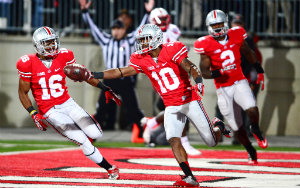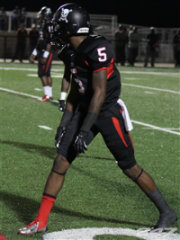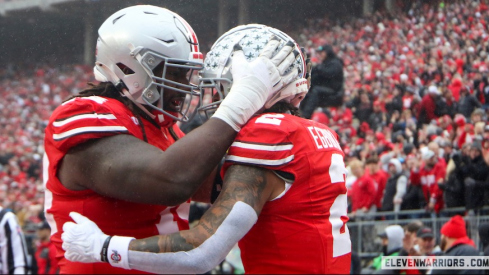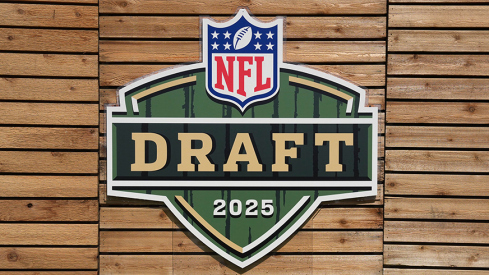It's Wednesday, so it's time for some data analysis and bad puns of terrible romantic comedies.
 OSU will need Philly Brown to have a lot of these in '13
OSU will need Philly Brown to have a lot of these in '13This week I'm taking a look at Ohio State receivers: what the typical OSU receiver looks like, how much they produce for the offense, how the receiving rotation has worked, and what Meyer might expect for next season.
The abysmal passing offense in 2011 was broken in almost every facet, from sloppy quarterback mechanics, scripted play calling, receivers who didn't get open, and a line that allowed far too many sacks.
However, the lows of the 2011 season made the highs of 2012 that much better. Devin Smith and Corey Brown emerged as legitimate receiving threats, Braxton got more comfortable, and the offense was actually designed to score points this time.
Thanks to a great dataset, we can take a closer look at how well each receiver did in 2012 and what we might expect in 2013. The good news? The only real loss to the receiving core was Jake Stoneburner, and he finished a distant third on the team in almost every receiving statistic of note.
The even better news? Ohio State has a fantastic crop of receivers coming in that should immediately challenge for a slot in receiving rotation.
how productive was each player?
It's no surprise that Devin Smith and Corey Brown were the most productive receivers last season. Corey Brown had 669 yards on 60 receptions and 85 targets (70.6% catch rate), while Smith had 618 yards from 30 receptions and 58 targets (51.7% catch rate).
| Yards per target | Target % | catch Rate | |
|---|---|---|---|
| Brown | 8 | 32% | 60/85 (70.6%) |
| Smith | 10.7 | 21.8% | 30/58 (51.7%) |
| Stoneburner | 8.1 | 12.4% | 16/33 (48.5%) |
| Spencer | 5.7 | 8.6% | 12/23 (52.2%) |
| Vannett | 7.5 | 5.3% | 9/14 (64.3%) |
| Heuerman | 7.3 | 4.9% | 8/13 (61.5%) |
| Hyde | 4.5 | 4.1% | 8/11 (72.7%) |
The best measure of receiver production is likely yards per target (YPT), which takes both catch rate and receiving yards into account. While Corey Brown was a remarkably more reliable receiver than Devin Smith, Smith's penchant for big plays made his yards per target numbers stand out. Smith finished with 10.7 YPT compared to Brown's 8.
Connelly places the catch rate floor for elite receivers at 55%, so Devin Smith doesn't quite qualify there. However, Brown qualifies for elite receiver status in many respects, including yards per target, catch rate, top team target, and >25% target rate. Brown should absolutely set his sights on 1000 total receiving yards.
Only Hyde, Vannett, and Heuerman had more than 10 targets last season, and all three had under eight YPT. Vannett and Heuerman were almost interchangeable statistically, with Heuerman picking up 7.3 YPT and Vannett at 7.5.
 Corey Smith should push for time
Corey Smith should push for timeThe tight ends were almost only a part of the passing game on standard downs (defined as first down, second down with less than 8 yards to go, and third and fourth with less than 5 to go), with just four total targets between them on passing downs. This is something Meyer and Herman can certainly play with next season by featuring the tight ends, running backs, and hybrid positions more on traditional passing downs.
Looking nationally, team-leading Big 12 receivers typically receive roughly twice as many targets, but just ten individual receivers ended with over ten yards per target.
HOW IMPORTANT WAS EACH PLAYER TO THE TEAM?
Philly Brown was targeted on 32% of all passes, while Smith received just under 22%. Two guys received over half of all targets throughout the 2012 season, while Stoneburner, Spencer, Vannett, Heuerman, Fields, and Michael Thomas fought for the scraps.
Interestingly, when you disaggregate the data into standard and passing downs, Smith and Brown were targeted almost equally on standard downs, but Brown was targeted over twice as often (38% to 17%) as Smith on passing downs.
This suggests that Braxton trusted Corey more to pick up the first down, even though we know it was Devin Smith who hauls in the game winners.
How Good are the New Guys?
The funny thing is that this data will likely look much different next season. Ohio State has four four-star or better wide receiver recruits coming in for 2013, and it wouldn't be a surprise to see any one of them challenge for a spot in the rotation.
Based on data from the past seven seasons at Ohio State, we shouldn't expect more than four guys to be big contributors even with the receiving core having a higher average star rating than in years past. Last season had a top two and then five guys with roughly equal targets. I expect next season to be more like years past, with a more equitable distribution of targets.
If we assume (and maybe we shouldn't) that Smith and Brown hold on to their starting spots, which one or two of Dontre Wilson, Jalin Marshall, Corey Smith, and James Clark do you expect to crack that top four? This doesn't include Jordan Hall returning to the hybrid position or Michael Thomas, who has worked with Braxton throughout the offseason.
Zach Smith, Meyer, and Herman can all probably rest a little bit easier for the time being. The offense returns two solid receivers, has loads of incoming talent, and a few older guys are pushing for a bigger role.
With a Mr. Reliable in Brown, a how-did-he-get-behind-everyone speedster in Smith, and a host of solid second options, Herman can begin to vary his passing strategy, especially on passing downs.

